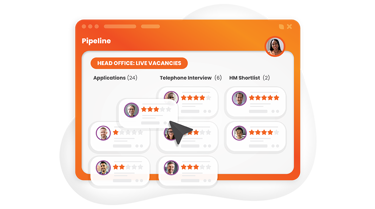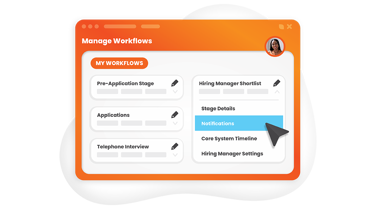What is An ATS System and How Does it Work?
This is a deeper dive article - take your time with it, or consider bookmarking if you want to come back to it. In this guide, we’ll explain what an ATS is, how it works, and the key features you should look for to modernise your recruitment process.
/Eploy-Notes-Banner.png?center=0%2C0&height=175&heightratio=1.915151515151515&width=336)
Hiring is complex, especially at scale. That’s why 99% of Fortune 500 companies use Applicant Tracking Systems (ATS) to streamline hiring, reduce admin, and improve candidate experience. And 94% of recruiters agree that their ATS had a positive impact on their organisation’s hiring processes.
What Is an Applicant Tracking System (ATS)
An Applicant Tracking System (ATS) is recruitment software that helps teams manage every step of the hiring process: posting jobs, reviewing applications, scheduling interviews, and onboarding candidates.
Instead of relying on spreadsheets or manual tasks, an ATS automates repetitive work, improves candidate experience, and gives hiring teams the tools they need to make faster, smarter decisions.
And while applicant tracking platforms offer a multitude of features, useful for a variety of stakeholders, here are some of the key features highly valued by Talent Acquisition professionals:
- Job requisition workflows to accurately raise jobs and get approval quickly to speed up the requisition process.
- Job advertising tools, such as multiposters, to post straight from your ATS into your favourite Job Boards.
- Candidate Screening to help TAs save time manually sifting through CVs, enabling them to spend more time engaging with the shortlisted candidates.
- Interview scheduling tools eliminate unnecessary back-and-forth communication between hiring managers and applicants by allowing them to select the best available time slot for their interview.
- Reporting and Recruitment Analytics introduce full visibility of recruitment metrics and give Talent Acquisition teams an understanding of the successes and bottlenecks in their recruitment strategy.
- Smooth online applicationprocess reduces candidate drop-off rates. Features like social network sign-ups and the ability to pause and resume applications create a smoother application process for candidates, who, in return, are less likely to drop out.
- Integration with other applications, such as Right-to-Work checks, Assessment Testing, HRMS, and Accessibility tools, further streamlines the hiring process for all stakeholders and introduces a fairer and more inclusive recruitment process.
- Built-in GDPR Compliance Tools and Audit Trail ensure that your Applicant Tracking System vendor provides tools that help you comply with your obligations as a data controller and supply a reliable audit trail to protect any personal data you hold.
- Employee Referrals allow recruiters to tap into a pool of highly qualified talent recommended by your current employees. Empowering your team to refer their networks enhances engagement, streamlines hiring processes, and helps you access a pool of highly qualified candidates through trusted connections.
- Offers, Onboarding and Contract Management Features streamline the onboarding process, enhancing the candidate experience, freeing up time and reducing human error.
Overall, the functionality of an ATS helps streamline your recruitment process, whilst providing the best experience possible to your applicants. It simplifies selecting a candidate and keeping up with the multi-stage process of interviews, assessments, and any other processes that may take place ahead of a hire.

How Does an ATS System Work?
An ATS software platform helps recruitment teams and hiring managers track the candidate’s progress from their initial application to onboarding and contract signing. By simplifying and automating hiring processes, an applicant tracking system helps you attract, engage, recruit and onboard candidates faster, with a better candidate experience. An ATS can recognise keywords within the CV that match the job description and specification. Through this process, it can recognise and extract qualifications, skills, and even hobbies, and then sort the candidates based on their unique features and skills.
An ATS can be a real lifesaver for medium to large organisations that receive a high volume of applications for their vacancies. Regardless of the recruiter or TA professional you ask, many of them will say the worst part of their role is having to sort through CVs that don’t meet the necessary qualifications or aren’t really relevant to the job opening. It can take up large amounts of the recruitment team's time, which could be used to engage with candidates. By recognising keywords, an ATS system can filter out the candidates who aren't the right fit for your vacancy. However, they can still be added to your talent pools and considered for better-suited opportunities in the future.
What are the benefits of using an ATS?
Applicant Tracking Systems can vary greatly in the functionality they offer. Below are some of the benefits you can expect to gain from using an ATS, yet this list is just the tip of the iceberg. You can delve deeper by watching this short video from a TA professional on maximising potential of an ATS.
1. Faster time-to-hire
A study by GetApp reveals that 86% of recruiters say using an ATS has increased the speed at which they hire candidates. Eploy’s customer Arco was able to reduce its time to hire by 46% by reducing manual admin and identifying process bottlenecks.
Using an ATS system helps streamline the recruitment process, eliminate the administrative burden from the recruitment team’s day-to-day life, enables TAs to easily raise new jobs and automate usually time-consuming candidate Right-to-Work checks…
2. Reduced the cost per hire
An Applicant Tracking System equips you with the required tools to streamline your processes, eliminate manual administrative tasks, build warm candidate talent pools and utilise employee referral features to attract skilled candidates who are likely to be a great cultural fit. An ATS system also helps reduce your reliance on agencies to fill vacancies, which can be a costly way to attract talent.
Using an ATS, Samworth Brothers were able to achieve £150,000 on target savings of agency spend.
3. Better Candidate Experience
An ATS enhances candidate experience by providing a smooth and seamless application process and onboarding. It reduces the need for back-and-forth between the TA team and the candidate, allowing the candidates to save unfinished applications and access all the relevant information and documents in their candidate portal. Recruitment teams can also use an ATS to automate personalised emails and SMS contact, which can improve engagement and keep the candidate updated throughout the process, rather than be left wondering whether they’re unsuccessful, but no one has told them.

4. More Inclusive Hiring
Did you know that diverse teams are 1.7 times more innovative than their competitors? DEI has become a significant driver of organisational success in recent years, making it even more crucial to ensure your recruitment process is up to standard to attract diverse talent.
Using recruitment tools, like an ATS system, can help you ensure fair, unbiased and compliant hiring. An Applicant Tracking System can facilitate the creation of unbiased job descriptions and communications. With compelling features that help ensure language neutrality and inclusivity, actively supporting your efforts to attract a diverse candidate pool. By eliminating unconscious bias, you broaden your talent reach, enrich your workplace culture, and strengthen compliance with DE&I regulations.
5. Streamlined onboarding
Eploy’s ATS ensures a great candidate experience; from making the offer, to their first day on the job, ensuring a smooth start for every new hire. A good ATS will allow you to create offers and contracts, which then can be signed by candidates digitally. Recruitment teams can also build out their own customisable onboarding workflows that work with your processes, also offering a seamless HR & Payroll integration.
6. Real-Time Recruitment Analytics
An Applicant Tracking System helps Talent Acquisition teams to measure and track important recruitment data - enabling them to make more data-driven recruitment decisions. For example, Eploy enables teams to build dashboards to suit your recruitment needs, providing your Talent Acquisition team with full visibility of the most recent Recruitment Analytics.

7. Built-in GDPR Compliance
A GDPR Compliant Applicant Tracking System helps you comply with your obligations as a data controller. Tools like GDPR Consent Management, Candidate Data Anonymisation, GDPR Compliant Candidate Communications, correctly set up Consents & Preferences, and a reliable Audit Trail are all part of ways an ATS can help you ensure compliance in your processes.

How to Choose an Applicant Tracking System?
Choosing an Applicant Tracking System can seem like a daunting task. To help you better understand if a vendor is a good fit, you can ask these questions:
- Which of your customers is most similar to us, and what results have they achieved?
- How has your product roadmap evolved based on customer feedback?
- What's your methodology for ensuring implementation success?
- Show us how your API works with real integration examples.
- How do you handle data migration from our current system?
- What's your disaster recovery and business continuity approach?
- How do you help customers maximise their ROI over time?
Watch this short video to learn from a TA professional on tips for how to differentiate between ATS vendors with similar features.
Key Features of the Best Applicant Tracking System
Modern-day ATS systems offer a huge selection of capabilities, however, it’s important not to get lost in the shine and excitement of all the possibilities. It’s crucial to ensure that the ATS system you are looking at is able to cover the key features and cover them really well.
Watch : This short video is essential to avoid common pitfalls when undertaking an ATS projects.
Such foundation features that every ATS should have include:
- Job Requisitions and Approval - Your system should streamline the entire job raising process, from initial request through approval workflows to job posting. Look for: automated approval routing based on role level or budget; job template libraries to speed up posting; integration with your HCM for post & position management.
- Online Applications - This is where many candidates form their first impression of your organisation. Essential elements include CV parsing to auto-populate application forms; save-and-resume functionality for longer applications; mobile-optimised application process; social login options.
- Interview management - Manual interview scheduling is a time-consuming process. Your ATS should provide self-service interview booking for candidates; calendar integration for all stakeholders; video interview capabilities; automated reminders and confirmations.
We hope you enjoyed this introduction to what an ATS is, how it works, and the key features you should look for to modernise your recruitment process.
Our video and webinar resources include a series of interviews with a TA professional who shares hints, tips and considerations for how to prepare for implementing an ATS, Getting stakeholder engagement and recommendations for selecting a shortlist of vendors: Watch here.

The Ultimate Applicant Tracking System Software: Achieve Hiring Excellence with Eploy
Eploy is the complete cloud-based Talent Acquisition Platform for modern in-house recruitment teams. Combining Applicant Tracking, Recruitment CRM, Onboarding, Employee Referrals and Analytics into a unified web-based platform integrated seamlessly with your careers site to provide an excellent candidate experience.
The best way to learn about Eploy is to see it in action. One of our experts will customise a demonstration following a quick consultation. No hard sell, no strings attached. Just some winning ideas to help you.
Eploy’s FAQs
Answers to frequently asked questions about ATS systems.